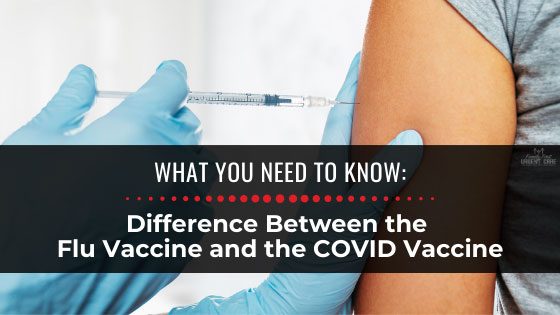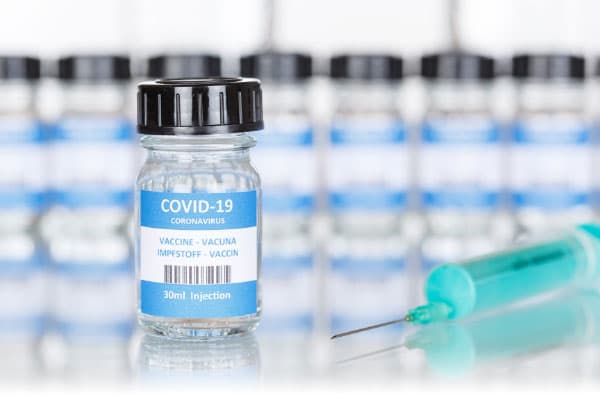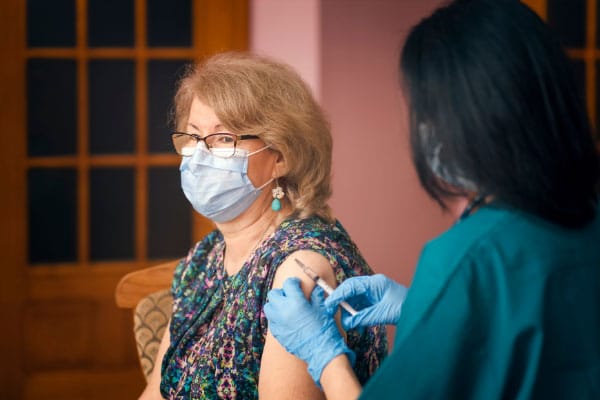
At what appeared to be the initial onset of coronavirus within the United States, a comparison between the flu and COVID-19 was a part of the conversation. However, despite some initial reports by media, the medical community says there are some critical distinctions between these diseases, as well as the flu vaccine and the COVID vaccine. Learning about the differences between the flu, coronavirus, and their respective vaccines can be helpful in knowing what symptoms to look for and how you can potentially protect yourself against each of these viruses.
About the Flu
The flu is caused by an influenza virus. Because of its viral nature, it can spread from human to human by touching commonly used surfaces that host germs or via contaminated respiratory droplets. The influenza virus is primarily active between fall and winter and largely dissipates during the spring and summer.
The most common symptoms associated with contracting the flu can include:
- Achiness
- Head and chest congestion
- Coughing
- Fatigue
- Fever or persistent chills
- Headaches
- Nausea and/or vomiting
- Sore throat

While this list of symptoms is not an exhaustive one, this list in combination with a nasal swab test is generally considered a foundation for diagnosing the flu.
Breaking Down the Flu Vaccine
As viruses continue over time, it is common for them to change or mutate. It is for this reason that health professionals have identified three main types of flu viruses: Influenza A, Influenza B, and Influenza C. On average, Influenza A and B are considered to exhibit more severe symptoms than those which are associated with Influenza C.
Each year, hundreds of thousands of medical centers and pharmacies administer the flu vaccine to individuals who request it. In most of America, the vaccine is available via two options:
1. Flu Shot.
A flu shot is typically given in the upper arm and does not contain a live virus. Side effects of the shot are usually minor in nature including soreness of the arm that received the injection, slight achiness, or a mild fever. These symptoms seldom last more than a day or two.

2. Nasal Spray.
This second option is a nasal spray that is comprised of a live, but weak virus. The mist is sprayed directly into a patient’s nose. As with the shot, the mist may also cause some patients to experience mild symptoms such as achiness, fever, or coughing. Some patients may not be eligible depending on their age or if they already have a weakened immune system.

Effectiveness of the Flu Vaccine
Past studies have shown that, in general, getting the flu vaccine can reduce the risk of flu related illness by between forty and sixty percent during a flu season in which the type of vaccine given matches the type of flu circulating. After receiving the flu shot, it can take approximately two weeks for the body to build up antibodies in response.
When it comes to effectiveness, the Centers for Disease Control’s (CDC) website says scientific studies support the following:
- Getting the flu vaccination may help keep you from getting sick with the flu.
- The vaccine has been shown to reduce the seriousness of illness.
- This type of vaccination can minimize risk of flu-related hospitalization for children, adults, and older adults.
- The flu vaccine can be a key preventative measure for individuals experiencing chronic health conditions.
- Individuals who are vaccinated may also be protecting others by doing so.

About COVID-19
COVID-19, more commonly called coronavirus, is a newer virus suspected to have originated in the year 2019. Much like the flu, it is estimated to spread through infected respiratory droplets that primarily circulate in the air or that are found on commonly touched surfaces. Most scientists do believe the coronavirus to be more contagious than the flu, especially the latest variants. Though the virus is relatively new, it is not currently thought to be seasonal like the flu.
Symptoms of coronavirus can vary from individual to individual, however, some of the most common symptoms of COVID-19 can include:
![]() Aches in the muscles and body
Aches in the muscles and body
![]() Chills or a fever
Chills or a fever
![]() Congestion or a runny nose
Congestion or a runny nose
![]() Coughing
Coughing
![]() Diarrhea
Diarrhea
![]() Difficulty breathing or shortness of breath
Difficulty breathing or shortness of breath
![]() Loss of smell and/or taste
Loss of smell and/or taste
![]() Sore throat
Sore throat
![]() Tiredness
Tiredness
![]() Upset stomach or vomiting
Upset stomach or vomiting
Symptoms associated with coronavirus are still evolving, so this list should not be considered complete.
Breaking Down the Vaccines
At the time of press, there are three vaccinations available for the coronavirus, and they are:
- Moderna COVID-19 Vaccine. This vaccine currently consists of one shot, a waiting period of twenty-eight days, and then a second shot. It is currently available to people age eighteen years and older.
- Pfizer-BioNTech COVID-19 Vaccine. This vaccine also consists of two shots but is separated by a twenty-one-day waiting period in between.
- Johnson & Johnson’s Janssen COVID-19 Vaccine. This is the newest vaccine available, and this one is unique in that developers say only one shot is required for vaccination.

None of these vaccines contain a live virus. Each vaccine indicates the possibility of mostly mild side effects.
Effectiveness of COVID-19 Vaccines
All three of the above vaccines have been authorized and are suggested to prevent coronavirus or make the symptoms less severe. Disease experts estimate that after becoming fully vaccinated, individuals may not build up an adequate level of antibodies until two weeks or more afterward.
Moderna, Pfizer, and Johnson & Johnson all currently have different efficacy rates:
- The Moderna vaccine is estimated to be just over ninety-four percent effective at preventing laboratory confirmed COVID in individuals who received two doses and were not previously infected.
- The Pfizer vaccine is estimated to be ninety-five percent effective at preventing laboratory confirmed COVID in individuals without a previous infection.
- The Johnson & Johnson vaccine is estimated to be sixty-six percent effective against general COVID-19 illness and eighty-five percent effective at preventing severe illness.

Scientists are still studying the effectiveness of each of these vaccines against new variants of the virus.
There are some critical differences between the flu vaccine and the COVID vaccine. Even amongst the available COVID-19 vaccines there are some additional distinctions. Educate yourself on what is involved, what to expect, and how to best protect yourself against these viruses.
- The Dangers of Heat Stroke - August 2, 2022
- Health Devices and Supplies For Home - July 19, 2022
- Hydration for Houston’s Summer Heat - July 1, 2022



